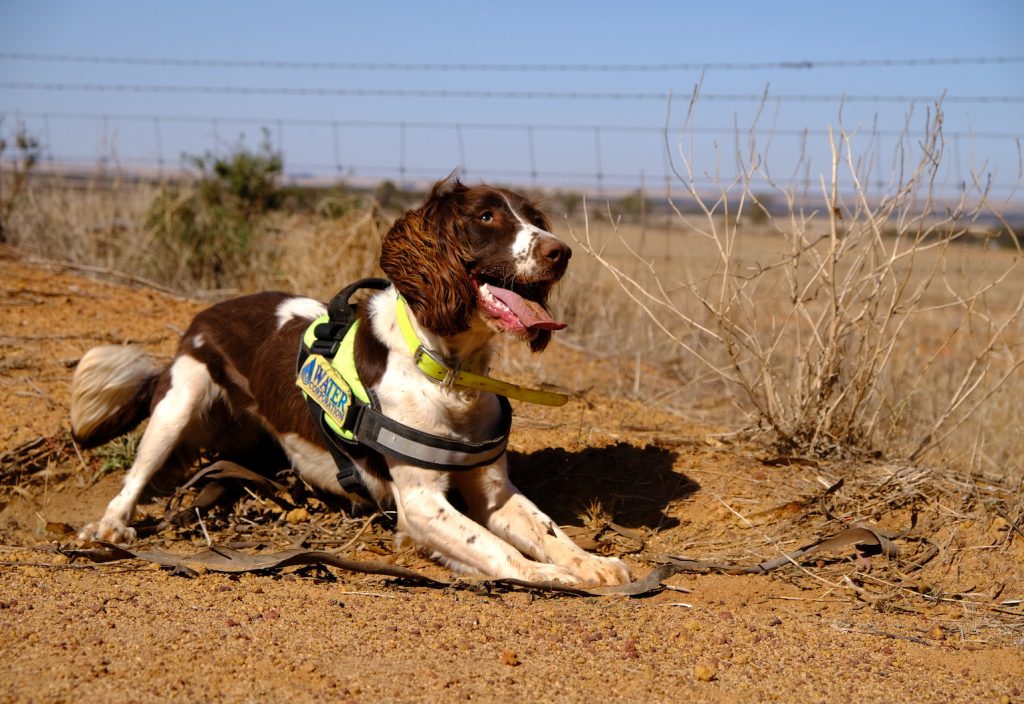Kep, Australia’s first ever water leak detection dog, and her handler Andrew Blair, can achieve in one day what takes humans and machines a week.
“I never imagined landing myself a job like this,” says Blair from a site in remote Western Australia. “I’m working with the best dog in the world, and for her, there’s nothing she enjoys more than searching for her target – leaking water.”
Kep is an English springer spaniel who started working with Western Australia’s Water Corporation in 2018 after 12 weeks of intensive training with a specialist dog trainer in New South Wales. Her outstanding hearing and sense of smell don’t just run in the breed, but in her family. Her dad Tommy is an experienced detection dog who took part in Water Corporation’s initial trial with canine helpers.
“The reason she’s so good at detecting leaks – specifically underground chlorinated water – is because that’s the only thing I trained her to do, apart from obedience,” Blair says.
“In her training, she goes through a process of discriminating against similar scents. This gives her the ability to find water leaks, even when it’s raining or there are rivers nearby. We recently had some thunderstorms here in Perth, and in a flooded area Kep found a leak amongst wet, muddy clay.”
Since Kep began working with Water Corporation in 2018, she’s discovered leaks that were draining a total of 80 Olympic-sized swimming pools worth of water annually. Many of these had been relatively minor, with as little as five litres of water leaking a minute. However, given some of the leaks have likely gone undetected over a period of 10 years, they represent a significant loss of water.
“We have humans doing the same work with acoustics, but it takes well over a week to cover five kilometeres step-by-step with a microphone on the ground,” Blair says. “Kep’s incredibly effective at covering ground at a much faster rate – she can do five km in a day.”
Blair is also trained in leak detection. He does an investigation with acoustic equipment to confirm Kep’s findings so that he doesn’t send operators to remote locations for false alarms.

“On a typical day in the field, we’ll be searching about five kilometres of pipe covering about 10 kilometres on the ground. But Kep’s often covering about three times that, the way she runs around like a maniac,” says Blair.
“When she’s resting, that is my chance to explore ahead without interfering in the search area too much and make sure that everything’s safe for her on the ground. Once we’ve finished our runs for the day, she needs to be thoroughly checked over for grass seeds. It often takes an hour a day to get every single one.”
If Kep’s path to this unusual career was written in the stars, Blair’s was a little more conventional. He began his career at Water Corporation as a hydrographer, looking at water flows and meteorological observations before moving into pipe pressure investigations, flows and leaks.
Blair had a background working with dogs, including training his own dog on a cattle station and working with explosive ordnance detection dogs in Afghanistan with the Australian Army. When the utility was looking for someone to partner with Kep, Blair was a perfect fit for the role.
“Nowadays, we work on a monthly schedule. Three weeks out of four, we’re out in the field, and one week is spent doing administration, planning and training,” he says.
“Kep lives with me and my family, and on weekends gets to relax like a normal dog. On Sunday afternoon, I’ll take her away to her own space to rest and be away from stimulation.
“When we get to work on Monday, there’s almost like a buildup of energy and excitement and she just can’t wait to do her job.”
As one of only a handful of people in the world working in this specialised field, Blair is regularly in touch with counterparts in Australia and overseas to problem solve.
“I talk to a man that came into his job as a canine trainer regularly about how to replicate odours in the dog’s training program, which is really difficult,” he says.
“You can’t just pour some tap water on the ground – there’s a whole lot of other conditions that need to be checked, such as soil types, the type of pipe it’s coming from, depth underground, and wetness of the soil.”
Blair and Kep are now sharing their expertise with utilities around the country to help other canine teams save our most precious resource.
To learn more about Water Corporation’s commitment to fixing leaks and saving water, visit its website.

